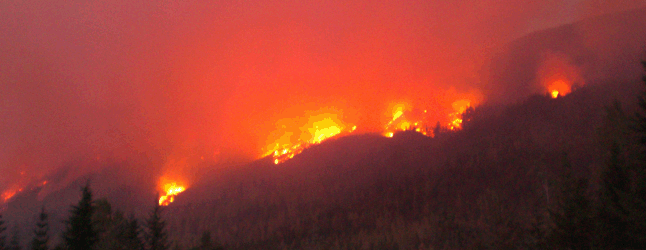
If you’re feeling somewhat uneasy about our unseasonably warm, dry weather when you watch coverage of the mammoth wildfire at Fort MacMurray you should know this: You are not alone.
The need for our seasonal spring rains is a staple of casual conversation across Revelstoke. And many Revelstokians are donating what they can to help our friends in Alberta. If you’re not sure how to do that here is a message from the Chamber of Commerce:
“Like you, we have been watching the situation in Fort McMurray over the last few days and been saddened by the disaster that is unfolding there,” Executive Director Judy Goodman said in a statement released on Monday, May 9.
“This is the largest wildfire evacuation in Alberta’s history. Unparalleled. Devastating.
“Fort McMurray Chamber of Commerce has more than 500 members who will be worried about their employees, their businesses and their futures. This type of disaster is hard to watch from afar. We know that in these communities, such as Lac La Biche and Edmonton, communities both large and small, our local chambers are part of the grassroots efforts to provide for those being evacuated. It’s a network like no other.
“Apart from the personal stories of loss, there will be business continuity issues in the days to come, once the fire situation is resolved. The humanitarian needs must come first. Please help by donating what you can to the Red Cross locally or online Donate Now!”
We’ve had our share of dangerous, unchecked and devastating forest fires here in BC. We remember the 2003 fire season when part of Kelowna burned and even in Revelstoke we had some ugly fires virtually on our doorsteps at Mount Macpherson and Mount Mackenzie.
According to a media briefing package issued to regional journalists by the Southeast BC Fire Centre in Castlegar, every year in British Columbia there are, on average, more than 2,000 wildfires.
“Over 92 percent of these fires are extinguished at a size of less than four hectares and are therefore regarded as a successful initial attack. In British Columbia, half of our wildfires are lightning-caused and half are person-caused.”
Those fires deemed to be a high priority are subject to immediate and vigorous suppression by initial attack crews. Many fires require additional support in the form of air tankers or helitankers, some of which are based out of the Revelstoke Airport each summer.
The briefing documents note that despite the initial attack strategy’s high success rate, every summer has its share of large wildfires, also known as project fires.
“When fires spread beyond the capacity of initial attack crews, we call upon unit crews and contracted fire crews,” the document said. “When fires burn for extended periods, or when there is a very heavy work load, we may mobilize specialized fire support personnel including incident management and information teams. Project fires may make use of mobile fire camps, designed to provide support and accommodation for the hundreds of people often required on larger incidents.”
Occasionally the fire season is so troublesome and some wildfires are so large that BC accepts aid from other provinces, American states and even from countries as far away as New Zealand and Australia.
British Columbia is a member of the Canadian Interagency Forest Fire Center (CIFFC), located in Winnipeg. Through mutual-aid resource-sharing agreements, we can obtain assistance from other provinces and territories and can assist other fire agencies as needed.
The Wildfire Service has established a Forest Fire Danger Rating System that provides updated information to the public about the danger level (low, moderate, high, and extreme) throughout the province based on the relationship between weather elements, fuel moisture and potential fire behaviour in various forest types
The fire danger rating is used by BCWS staff to keep the public informed about the risk of wildfires and to plan for the allocation of resources. Information is collected from networked automated weather stations. This information (temperature, relative humidity, wind speed and precipitation) is used to calculate the forest fire danger rating.
What the Danger Class Ratings mean:
- Low: Fire danger is minimal.
- Moderate: Carry out any forest activities with caution.
- High: Fire hazard is serious. Extreme caution must be used in any forest activities. Burning permits and industrial activities may be restricted.
Extreme: Extremely high fire hazard. High-risk activities may be restricted, including industrialoperations, backyard burning, fireworks and campfires.
The public is kept informed about the forest fire danger level throughout the province via road-side signs, public notices, the BCWS fire information phone line and the www.bcwildfire.ca website.
While there is much comfort in knowing that the men and women who fight wildfires are superbly trained and extraordinarily motivated, members of the general public have an important role to play by keeping their eyes peeled for signs of fire.
If you spot a forest fire you can report it by calling *5555 on your cell phone or dial 1-800-663-5555. Both numbers are toll free.
Additional information is available online from the BC Wildfire Service website:
Information about the Protection Program can be found at www.bcwildfire.ca;
Current fire information can be found at bcwildfire.ca/Situation/; and
Information on bans and restrictions can be found at bcwildfire.ca/hprScripts/WildfireNews/Bans.asp.
Please click hre to read a 2011 story about what the City has been doing to prepare for a major fire.



